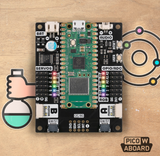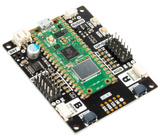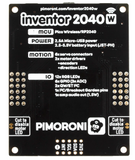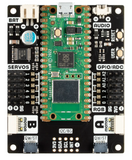Inventor 2040 W (Pico W Aboard)
by Pimoroni
An all-in-one board for making battery powered contraptions that can move, (optionally) make noise, and talk to the internet!
Free shipping on this item!!!
Inventor 2040 is a multi-talented board that does (almost) everything you might want a robot, prop or other mechanical thing to do. Drive a couple of fancy motors with encoders attached? Yep! Add up to six servos? Sure? Attach a little speaker so you can make noise? No problem! It's also got a battery connector so you can power your inventions from AA/AAA or LiPo batteries and carry your miniature automaton/animated top hat/treasure chest that growls at your enemies around with you untethered.
You also get a ton of options for hooking up sensors and other gubbins - there's two Qw/ST connectors (and an unpopulated Breakout Garden slot) for attaching breakouts, three ADC pins for analog sensors, photoresistors and such, and three spare digital GPIO you could use for LEDs, buttons or digital sensors. Speaking of LEDs, we've also somehow managed to fit in 12 addressable LEDs (AKA Neopixels) - one for each servo and GPIO/ADC channel (or just use the whole lot for making rainbows, that's fine too).
Best of all though, is the brains of the outfit - the onboard Raspberry Pi Pico W, which will give your creations 2.4GHz wireless connectivity. Use it to trigger your mechanical friends to do their thing remotely, or perhaps you can make a robotic bird that tweets, and also Tweets?
Features
- Raspberry Pi Pico W Aboard
- Dual Arm Cortex M0+ running at up to 133Mhz with 264kB of SRAM
- 2MB of QSPI flash supporting XiP
- Powered and programmable by USB micro-B
- 2.4GHz wireless
- 2 JST-SH connectors (6 pin) for attaching motors
- Dual H-Bridge motor driver (DRV8833)
- Per motor current limiting (0.5A)
- Per motor direction indicator LEDs
- 2 pin (Picoblade-compatible) connector for attaching speaker
- JST-PH (2 pin) connector for attaching battery (input voltage 2.5V - 5.5V*)
- 6 sets of header pins for connecting 3 pin hobby servos
- 6 sets of header pins for GPIO (3 of which are ADC capable)
- 12 x addressable RGB LEDs/Neopixels
- User button
- Reset button (built in Captain Resetti!)
- 2 x Qw/ST connectors for attaching breakouts
- Unpopulated headers for adding a Breakout Garden slot
- Fully assembled
- No soldering required (unless you want to add the Breakout Garden slot).
- C/C++ and MicroPython libraries
- Schematic (coming soon)
Motors, servos, batteries and speakers are sold separately.
Software
Our C/C++/MicroPython libraries provide an easy way to interface with the functions on this board. You'll get best performance using C++, but if you're a beginner we'd recommend using our batteries included MicroPython build for ease of getting started.
- Download pirate-brand MicroPython
- Getting Started with Raspberry Pi Pico
- Motor function reference
- Servo function reference
- MicroPython examples
- C++ examples
- Examples demonstrating wireless functionality are coming soon!
Please note that playing audio files (such as wavs and mp3s) is not yet supported in C/C++/MicroPython, but you can make very satisfying retro bleeps and bloops by PWMing the speaker (use a lower volume to avoid sounds being distorted).
Notes
- Measurements: 52mm x 66mm x 12mm (L x W x H). The mounting holes are M2.5 and 2.7mm in from each edge.
- The direction indicators for each motor can be disabled by cutting the "motor LED" traces on the rear.
- * The battery voltage range is dependent on what functions you're using! Minimum voltages from our testing:
- Motor driver stops working below about 2.9V
- Audio stops working below about 2.2V
- Pico stops working below about 1.9V
- You can have a battery and USB connected at the same time safely. The board will use whichever power source has the higher voltage (usually USB).
About Pico W Aboard
Our new Pico W Aboard products come with a built in Raspberry Pi Pico W. This means you get all the advantages of a RP2040 microcontroller - a speedy fast dual-core ARM processor, a dynamic, growing ecosystem and a choice of different programming methods to experiment with. Most excitingly though, Pico W has wireless connectivity, so your Pico/RP2040 devices can communicate with each other, and the internet! 🌍
Wireless is very new to Pico/RP2040 - be aware that things will move fast and change! Software support (wireless examples, tutorials, CircuitPython support etc) will take a little while to catch up. If you're an absolute beginner to Pico/RP2040, you might have a better experience with wireless if you wait until everything is a little more settled








